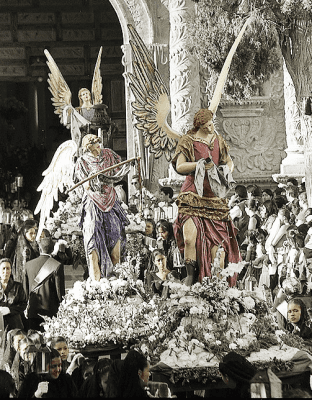We hear the term frequently at this time of year. It means a very busy time for Akumal, but does everyone know the real meaning of these words? Pascua is the Spanish term for Easter Sunday. Semana Santa locally means vacation – spring break. Schools and often businesses in Mexico close during these two weeks and many Mexican families go on holiday.
Easter in Mexico is a two-week holiday consisting of Semana Santa, Holy Week, which begins Palm Sunday and ends Easter Saturday, and Pascua, which goes from Easter Sunday to the following Saturday. Semana Santa is an important holiday in Mexican culture.

photo via mexperience.com
Across the country, Mexicans celebrate the last days of Christ during Holy Week with elaborate processions, ceremonies, and rituals. Most of the larger Semana Santa celebrations include a dramatic reenactment of the capture, trial, and crucifixion of Jesus. To be a part of these productions is a great honor and the actors are known for delivering inspiring and moving performances. Different regions of Mexico are known for practicing unique traditions during Semana Santa such as acts of physical torture, public displays of political/social ridicule, and displays of resolutions and commitment.
In Taxco, reenactments include penitentes – men and women who show their penitence and prove their faith by inflicting physical pain on their bodies, whipping themselves or carrying large religious objects on their backs. This is an ancient tradition that dates back to the middle ages and was introduced in Mexico by the Spanish more than 500 years ago. During the reenactments, the actor playing Jesus usually wears a real crown of thorns and carries a massive cross weighing hundreds of pounds over great distances to the scene of crucifixion.
In San Miguel de Allende, another Spanish-influenced tradition is celebrated during the Holy Week called “The Burning of the Judases.” In Spain, carpenters would make wooden dolls representing Judas, which would be hung and burned in town squares to punish Judas for betraying Christ. During the Inquisition, when the Spanish were burning real people for heresy, Mexicans protested by making dolls and dressing them like Spanish inquisitors and burning them instead of Judas. This evolved into the current tradition where giant Judases made from papier mâché are dressed and painted to resemble political and public figures unpopular with the public. The dolls are then hung and blown up with fireworks, scattering limbs in the street for children to collect as souvenirs. Famous Mexican artists like Diego Rivera and Frida Kahlo were strong proponents of the value of art in political commentary and quickly adopted the tradition of creating Judases.
Other traditions focus on different ways to show dedication and appreciation of Jesus’ sacrifice. In the Iztapalapa section of Mexico City, people called Nazarenes parade the streets before the procession of Christ, marching in promise to fulfill a manda, a religious promise, as payment for a granted favor by God. In many regions of Mexico, people show their devotion by visiting twelve different churches in a single day – one church for each apostle. In more remote regions like the Copper Canyon, local cultures mix Christian celebration with ancient native rituals, paying homage to both their Spanish and Indian heritage . In Playa del Carmen on Avenida Benito Juarez a procession re-enacting Jesus carrying the cross winds through city streets
— cut from Journey Mexico March 29, 2015

Leave a Reply